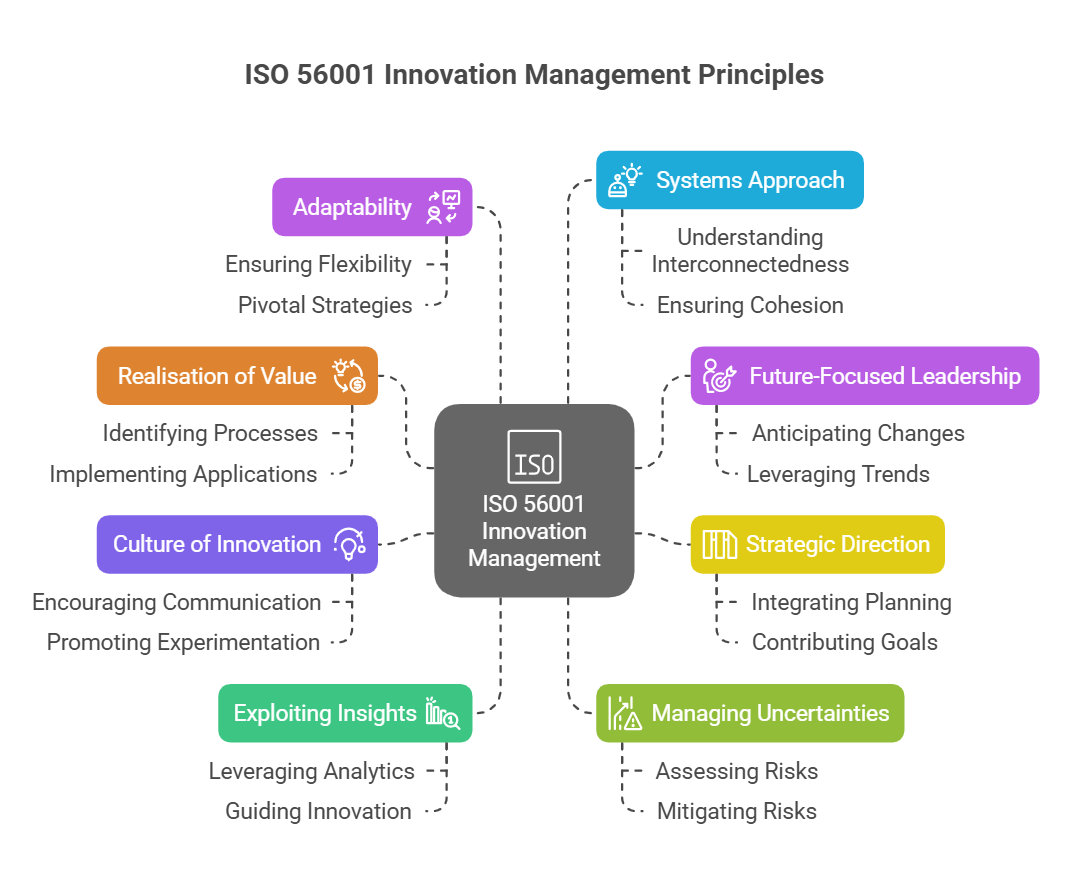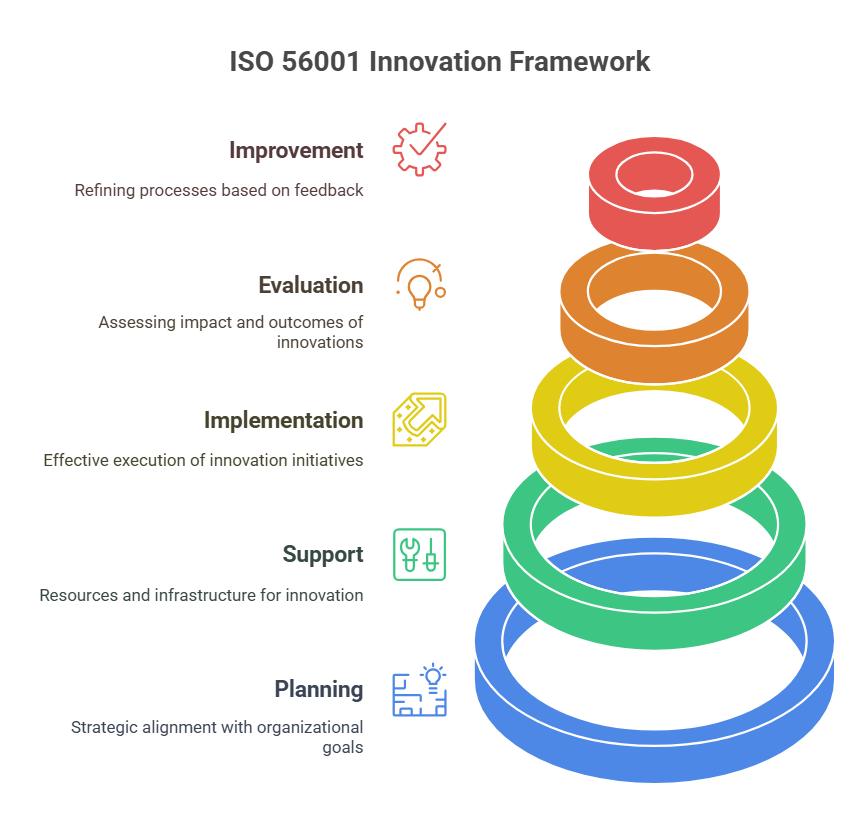
ISO 56001 is an international standard designed to guide organisations in establishing, implementing, maintaining, and continually improving an innovation management system.
It provides a structured framework to enhance innovation capabilities and ensure that innovation efforts align with organisational goals.
1. Realisation of Value
Innovation must ultimately create value for the organisation and its stakeholders.
This principle underscores the importance of translating innovative ideas into tangible outcomes, such as improved products, services, or processes, that deliver measurable benefits. Value realisation involves not only financial gains but also improvements in efficiency, customer satisfaction, and competitive advantage.
Organisations must focus on identifying and prioritising innovations that align with their strategic objectives and have the potential to generate significant impact.
2. Future-Focused Leadership
Leaders must adopt a forward-thinking mindset, anticipating future challenges and opportunities.
This principle encourages proactive decision-making and the development of strategies that prepare the organisation for long-term success in a rapidly evolving landscape. Future-focused leadership involves staying informed about emerging trends, technological advancements, and market shifts, while fostering a culture of adaptability and resilience within the organisation.
Leaders should also champion innovation by setting clear expectations, providing resources, and empowering teams to explore new ideas.
3. Strategic Direction
Innovation efforts should be closely aligned with the organisation’s overall business strategy.
This principle ensures that innovation is not pursued in isolation but is integrated into the broader vision and objectives of the organisation. Strategic direction involves defining clear innovation goals, identifying key areas of focus, and ensuring that innovation initiatives support the organisation’s mission and values.
By aligning innovation with strategy, organisations can maximise the impact of their efforts and avoid resource misallocation.
4. Culture of Innovation
A supportive environment is essential for innovation to thrive.
This principle highlights the need to nurture a culture that encourages creativity, collaboration, and risk-taking, while also providing psychological safety for employees to experiment and learn. A culture of innovation involves fostering open communication, celebrating successes, and learning from failures.
Leaders play a crucial role in modelling innovative behaviours and creating an atmosphere where employees feel empowered to contribute ideas and challenge the status quo.
5. Exploiting Insights
Data and insights are critical for informed decision-making in innovation.
This principle stresses the importance of leveraging information—both internal and external—to identify opportunities, assess risks, and guide innovation strategies. Exploiting insights involves gathering and analysing data from various sources, such as market research, customer feedback, and industry trends, to inform the innovation process.
Organisations should also invest in tools and technologies that enable them to collect, process, and interpret data effectively.
6. Managing Uncertainties
Innovation inherently involves uncertainty and risk.
This principle focuses on developing mechanisms to identify, assess, and mitigate risks, ensuring that innovation efforts remain resilient in the face of challenges. Managing uncertainties involves conducting thorough risk assessments, developing contingency plans, and fostering a culture of agility and adaptability.
Organisations should also encourage experimentation and iterative testing to minimise the impact of potential failures and learn from the process.
7. Adaptability
Organisations must remain flexible to respond to changing market conditions and emerging trends.
This principle encourages adaptability in processes, structures, and strategies to maintain relevance and competitiveness. Adaptability involves being open to change, embracing new technologies, and continuously refining approaches based on feedback and results.
Organisations should also foster a mindset of continuous learning and improvement, enabling them to pivot quickly in response to new opportunities or challenges.
8. Systems Approach
Innovation should be viewed as part of a larger organisational system.
This principle promotes a holistic perspective, ensuring that innovation processes are interconnected with other business functions and contribute to overall organisational effectiveness. A systems approach involves considering the interdependencies between innovation and other areas, such as operations, marketing, and finance, to ensure alignment and synergy.
By adopting a systems approach, organisations can optimise their innovation efforts and achieve sustainable growth.

To operationalise these principles, ISO 56001 outlines five key dimensions:
Improvement: Continuously refining innovation processes based on feedback and results to drive ongoing enhancement. This involves learning from experiences, adapting strategies, and fostering a culture of continuous improvement.
Planning: Developing a strategic plan for innovation that aligns with organisational goals. This involves setting clear objectives, identifying key focus areas, and allocating resources effectively.
Support: Providing the necessary resources, tools, and infrastructure to enable innovation. This includes investing in technology, training, and creating an environment that fosters creativity.
Implementation: Executing innovation initiatives effectively and efficiently. This involves managing projects, coordinating teams, and ensuring that innovations are delivered on time and within budget.
Evaluation: Assessing the impact and outcomes of innovation activities to measure success. This includes collecting data, analysing results, and identifying areas for improvement.
Why ISO 56001 Matters
ISO 56001 provides a systematic and standardised approach to innovation management, enabling organisations to:
- Enhance their innovation capabilities and stay competitive in a rapidly changing world.
- Align innovation efforts with strategic objectives to maximise impact.
- Foster a culture of continuous improvement and adaptability.
- Mitigate risks and uncertainties associated with innovation.
- Create sustainable value for stakeholders, including customers, employees, and shareholders.
By adhering to these principles and dimensions, organisations can build a robust innovation management system that drives long-term success and competitiveness. ISO 56001 serves as a valuable tool for organisations seeking to embed innovation into their DNA and achieve sustainable growth in an increasingly complex and dynamic business environment.
